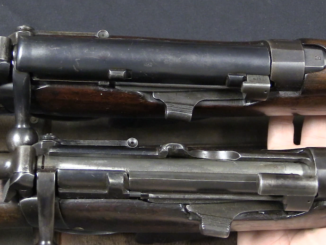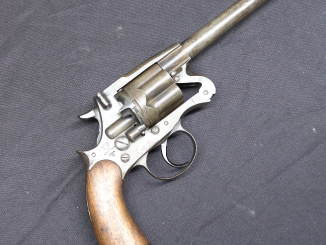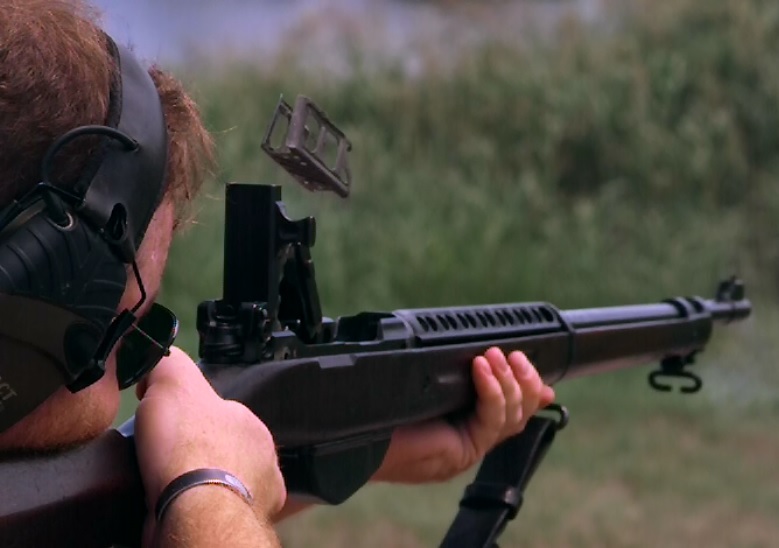Armament Research Services (ARES) is a specialist technical intelligence consultancy, offering expertise and analysis to a range of government and non-government entities in the arms and munitions field. For detailed photos of the guns in this video, don’t miss the ARES companion blog post!
The DeLisle carbine was a conversion of a standard SMLE rifle to the .45 ACP cartridge, feeding from modified 1911 pistol magazines. It was fitted with a 7″ (175mm) barrel and a very large integral suppressor. The combination of the subsonic cartridge, the large suppressor volume, and even a sound-dampening pad on the bolt handle made for an extremely quiet firearm. Although often compared to the Welrod silenced pistol, the DeLisle was intended specifically for special forces (Commando) use, and not for dropping into occupied territories.
The conversions were done by the Sterling company, and an order of 550 was placed, with 500 of those using a fixed wooden stock and 50 using a folding metal stock. The contract was cancelled in 1943, however, with only about 130 having been made (and only a single prototype of the folding stock model).
Today we will take a look at one of the prototypes, two of the standard production models, and the only existing folding stock example. While a number of companies have made reproduction DeLisles of varying quality, originals are very rare, and none of the reproduction have duplicated them entirely correctly.




One of my all time wants! I first read about the DeLisle in high school (45+years ago) and have been willing to trade my sinister gonads for one ever since.
“And now, you know too much!!” THUNK!
Just kidding! I would still hate to be on the receiving end of such a piece. And considering that few people apart from SWAT units (or the US Navy SEALS) or the forestry service (or even exterminators taking out Giant Sumatran Rats) would have a need for such items, is it surprising that nobody has made a modern reproduction of the DeLisle that works exactly like the original? This isn’t political by the way. It’s entirely technical: Why get a purpose made weapon that won’t have much support from the market when tons of other designs and customization options are available at a lower price? One could easily fit a suppressor to a pistol-caliber lever-action carbine with some well-done machining… or am I wrong?
I would say that if you already decided to manual repeating rifle for pistol-caliber round, straight-pull would give somewhat better rate-of-fire.
See for example SV-99 rifle (for .22 rim-fire cartridge):
http://modernfirearms.net/sniper/sniper-rifles/rus/sv99-e.html
Valkyerie Arms in Olympia, Washington makes a very nice reproduction in both suppressed and dummy models, along with some other interesting toys.I
http://www.valkyeriearms.com
Oops, botched the URL…
Should be:
http://www.valkyriearms.com
Two things, in two comments:
1. On the need/utility of suppressed carbines in general. I think there’s a lot more than you might think (in the US — I can’t speak to elsewhere), but it’s largely masked by the hassle of owning such a thing (again, in the US).
A lot of rural households, keeping poultry and such, have a “grab and go” rifle behind the door, for when you see a feral cat, possum, or other such varmint. I’m currently using a .22 in this capacity, but centerfire pistol cartridges (and pistol-class rifle cartridges like .32-20) are very good choices as well, with a little more punch for larger varmints such as wild dogs (which fortunately aren’t a problem around here.).
As for suppression, or quietness generally? That .22 I mentioned has a 27″ barrel; I choose this long barrel, and to shoot heavy subsonic ammo, because with the extra expansion of gasses, it’s only a little louder than a airgun. If you don’t understand the need for something quieter than a regular .22 carbine with high-velocity ammo (which IS pretty quiet, by the standard of centerfire rifles), you probably haven’t shot one in a barn or shed, with the walls reflecting the muzzle blast right back at you; it’s quite an unpleasant experience. We don’t “need” a suppressed centerfire gun, but we’d certainly benefit from it: compared with my .22, a suppressed carbine in any of .32 ACP, .380 ACP, or .45 ACP would deliver the slightly to much better terminal ballistics, with even lower noise, in a shorter and handier package (compare the De Lisle’s ~15″ suppressor to a 27″ barrel). It would likely weigh a bit more, but within reason that’s actually a benefit for off-hand shooting.
Of course, you might well ask, if a De Lisle-like suppressed carbine would be so great, why am I using an unsuppressed .22 instead? It basically comes down to the hassle of owning suppressors in the US; a $200 tax and 6+ months of waiting for paperwork, plus the promise of more paperwork and hassle making it difficult for me to ever sell it or even give it away, is just too much for me; I think there’s a lot more people who feel this way, and if the laws about suppressors are ever relaxed to the level of ordinary firearms, I think there will be a much bigger market for this sort of gun than you’d expect. (Not to get into politics, but a bill to do just that has just made it out of committee in the House of Representatives; it’s still a long way from becoming law, but even if it doesn’t pass this year, it seems likely we will see that change eventually.)
“$200 tax”
Does this also apply to internal silenced cartridges, for example hydraulic, see 1st image from top here:
https://raigap.dreamwidth.org/451765.html
?
Yes, it does — $200 tax per round, which effectively makes such ammunition “for collectors only”.
“we’d certainly benefit from it: compared with my .22, a suppressed carbine in any of .32 ACP, .380 ACP, or .45 ACP would deliver the slightly to much better terminal ballistics”
What about air-powered weapons like PCP rifles? Limited muzzle velocity is not issue, as anyway it has to be sub-sonic. It don’t need any mass-increasing device (“silencer”) and is additionally flame-less (relevant only when used during night) on the other hand it needs supply of bullets and tanks (of pressurized gas) rather than cartridges only.
Actually, there are both pre-charged pneumatic and “conventional” pump-up or even barrel-cocking or side-lever spring-type air rifles that easily exceed 1,200 f/s muzzle velocity. (The speed of sound at sea level pressure and 50 degrees F is 1,086 f/s). Calibers range from .177 and .22 for the pellet rifles on up to .30 inch for some PCPs, the latter firing “conventional” bullets rather than skirted diabolo-type pellets.
The more determinedly subsonic PCPs tend to be .45 to .50 caliber, launching conical bullets of up to 300 grains at velocities in the range of the .45 Long Colt and .45 ACP “standard velocity” rounds (850 to 950 f/s), and delivering muzzle energies in about that range (350 to 400 FPE). The moral being that while speed kills, weight hurts, too.
Anybody who thinks air guns can be safely disregarded as viable weapons for tactical missions doesn’t realize just ow much their design and construction have advanced in just the last ten years.
cheers
eon
“easily exceed 1,200 f/s muzzle velocity”
Yes, but that is anyway much less than full-power rifle, however as noted before it is not issue for that application
“.30 inch for some PCPs, the latter firing “conventional” bullets rather than skirted diabolo-type pellets.”
Which give how much velocity for how heavy bullet (.30″ bullets vary heavily, from 110 gr (M1 Carbine) to 220 gr (.300 H&H Magnum))?
PCPs are relatively quiet without a suppressor, but they’re even better suppressed. And in the US, while any threaded suppressor is deemed a firearm suppressor (whether or not you have a firearm with matching threads), suppressors that are integral to an airgun are completely unrestricted.
I’d likely go with a large-bore (9mm or more) suppressed PCP for a grab-and-go rifle, if I lived somewhere with a wild dog problem.
2. On suppressing lever-actions. It is a good idea, and it is a much cheaper/simpler route to “good-enough”, but there’s also some reasons a nolt action like the De Lisle is usually better.
The problem with lever-actions is that most of them, and almost all pistol-caliber lever-actions, have tubular magazines below the barrel, running most of the length of the barrel. So if you try to set one up with the combination of short barrel and long suppressor that makes the De Lisle both handy and quiet, you must either allow the magazine to extend into the suppressor and seal around it, or shorten the magazine to a few inches and live with very small magazine capacity. Both options are possible, but undesirable.
I’ve seen some suppressed lever-actions, and they typically leave the barrel full-length or nearly so, and thread the end for an ordinary suppressor. If you start with, say, a 16″ barrel, and add a suppressor the size of the De Lisle’s (~15″), you’ve got a total near 30″ — a long, clumsy rifle. So typically they use a much smaller suppressor, which will be both louder (because less supressor volume) and longer (because longer barrel) than a De Lisle-type layout. (Of course there’s been a lot of progress in suppressor design since the De Lisle, so a smaller modern suppressor may still be quieter. But a De Lisle-sized suppressor with modern baffles will be quieter yet.)
Bolt actions near universally feature box magazines, or other types that don’t interfere with the short barrel / long suppressor setup, so they’re good choices; the only downside is converting them to pistol caliber. Lever actions with box or rotary magazines like the Winchester 1895 or Savage 1895 would be great, but are typically made for rifle rounds; the conversion to pistol rounds would be no simpler than converting a bolt-action.
And while they don’t have the benefit of controlling action noise, semi-auto pistol caliber carbines commonly use box magazines and blowback operation (with no gas system in the way), so they’re pretty suitable too; something like the Kel-Tec or Hi-Point carbines, with a short barrel and modified handguard, would cover a lot of the practical uses — for anything where silencing is about hearing protection and comfort, the action noise is not really a problem.
Actually, thinking about semi-auto carbines… Why was the De Lisle a bolt action? How much was to avoid action noise, and how much was because the standard rifle was a bolt action? Probably some of both…
So if you ignore the current prevalence of suppressed AR-15s in .300 Blackout, and try to imagine a pistol-caliber carbine today for the same role as the De Lisle, with no military bolt-action rifle to base it on, I suspect the “right” answer would be a semi-auto with a bolt lock, allowing it to be operated as a pseudo-bolt-action when silence is golden, or unlocked for semi-auto use when “quiet enough” is good enough, but rapidity is essential.
I started out thinking of a Reising derivative with an extra step on the bolt carrier ramp to control locking vs. delay (not because it’s necessarily a great fit, but because I really like the Reising’s delayed-blowback mechanism)… Suddenly I got a vision of an AR-15 derivative with a weird hybrid of 5.56 and 9mm parts: a 9mm barrel with a standard 5.56 barrel extension, a heavy bolt carrier with no cam slot that holds a modified 5.56 bolt, a reciprocating charging handle that rotates (just like a bolt-action, but with only 22.5° throw) to engage/disengage the bolt lugs in the barrel extension, and of course a slot in the upper receiver for that charging handle. Straight blowback if you fire it with the lugs disengaged, quiet bolt-action if you lock and unlock each time.
That might actually be a pretty cool gun to build… goodness knows the world has enough AR-15s in it, but I think that one would be pretty unique. If/when they relax the laws on suppressors, I think I’ll seriously look into this.
“I suspect the “right” answer would be a semi-auto with a bolt lock, allowing it to be operated as a pseudo-bolt-action when silence is golden, or unlocked for semi-auto use when “quiet enough” is good enough, but rapidity is essential.”
Examples of such selective self-loading/manual-repeating weapons, are MAB Model F automatic pistol: http://www.deactivated-guns.co.uk/deactivated-guns/modern-deactivated-guns/deactivated-mab-model-f/prod_5502.html
and Mk22Mod0 (codenamed HUSHPUPPY) automatic pistol.
Both belongs to hand-gun category, but there is not reason which would prevent such solution in long-arms.
“.300 Blackout”
Soviet equivalent to that cartridge is 9×39 mm:
http://gunrf.ru/rg_patron_9x39_eng.html
however, main objective was to get better penetration capability (against personal armor) than earlier used systems (7,62 x 39 cartridge in 57-Н-231У iteration, 12,55 g bullet @ 293-310 m/s, used together with ПБС-1)
make that AR15 suppressed clone in 7.62x25mm Tokarev.
standard-issue Tokarev ammo is supersonic but damned powerful.
special-issue subsonic ammo in same cartridge could be loaded with 125gr or so spitzers. That might have been the .300 Mini-Whisper from decades ago.
and make the AR15 suppressed clone, chambered for 7.62x25mm Tokarev, a conventional gas-operated carbine, with a gas cutoff and side charger handle, to allow suuuuper quiet suppressed operation with the subsonic ammo.
“special-issue subsonic ammo”
Do you mean cartridge used for ППД-Брамит?
http://guns.allzip.org/topic/36/2040182.html
(notice thicker disk on photos, to allow longer bullet)
that cartridge was 7,62×25 case loaded with “Л” bullet from 7,62×54 R cartridge (bullet mass: 9,5 … 9,72 g) and powder charge giving muzzle velocity 250 m/s.
I hear you, Fyooz, and I do have a soft spot for 7.62×25. But what you’re talking about really amounts to just another .300 Blackout with a different chamber (Yeah, the side charging handle is not so common, but still a pretty standard mod for that “custom” touch.) On one hand, being so closely based on a popular setup is really a very practical choice, as you’ll never have trouble finding parts to repair or modify it, but on the other hand, I just find it boring.
And it also suffers a little in either complexity (suppressor wraps around gas system) or volume (suppressor starts at the gas block); certainly modern baffles can make it quiet enough despite this disadvantage, while keeping barrel+suppressor length in the neighborhood of 16″, but I’d rather make it even quieter by extending the suppressor’s reflex chamber all the way back to the barrel nut.
So if I did go with 7.62×25 (and I just might, though I think I’d rather something like 9mm where both supersonic and subsonic ammo are commercially available), I’d stick with the locking blowback scheme I outlined above. I might need to add more mass to the bolt carrier, maybe a lead or tungsten insert.
So… Why does the rifle with the folding stock have a tag with a radioactive symbol attached to the front sling swivel?
Maybe it was fitted with glowing radioactive night sights?
Maybe an anti-theft fob?
Handling a one of one weapon would be amazing (the folding stock version). Any chance of a link to the photo of the DeLisle in the wild with those folks during the Emergency?
The rear sight on the ‘production’ versions is from a Lanchester Mk1 SMG.
Regards
AlanD
Sydney
631 is an accession number of the folding-stock example for the collection. The other two De Lisles in the collection have sequential accession numbers 632 (sectionalised example) and 633.
There are a number of semi auto.22s out there that allowed the bolt handle to fold down converting it to a manually operated quiet rifle.
Krico made one as did Beretta but both were well above my budget when previous to 1992 you just walked into a french gunshop presented your carte de sejour and bought an ar15
Surprised that no one has mentioned the Armalon carbines from Britain – pistol-cartridge reworks of unissued Lee Enfields that as near as I can tell have never been imported to the US. Just from drooling on the Internet these are near the top of my win-the-lottery fantasy – I love my old Irish-surplus No. 4 and a short-action version in 9mm or .45 would be a hoot.
Interesting. I didn’t remember the Armalon PCs, but I am glad you did. Nifty conversions, I have to admit. However, the purist in me hates the idea of having original, “unissued Lee Enfields” butchered to produced these pistol-cartridge carbines. Or do they convert them around new old stock No. 4 actions?